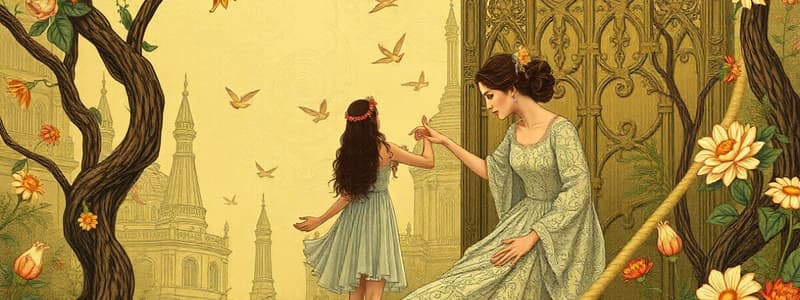Podcast
Questions and Answers
Which literary device often uses contrasting characters to highlight qualities of the protagonist?
Which literary device often uses contrasting characters to highlight qualities of the protagonist?
- Dramatic Arc
- Dramatic Foil (correct)
- Imagery
- Soliloquy
What theme explores the conflict between individual choices and societal pressures?
What theme explores the conflict between individual choices and societal pressures?
- Reckless Passion
- Individual Agency vs. Tyranny of Belonging (correct)
- Loyalty
- Honor
Which poetic device involves the repetition of consonant sounds at the beginning of words?
Which poetic device involves the repetition of consonant sounds at the beginning of words?
- Oxymoron
- Alliteration (correct)
- Imagery
- Onomatopoeia
Which motif contrasts the concepts of light and dark to convey meanings beyond the literal?
Which motif contrasts the concepts of light and dark to convey meanings beyond the literal?
What literary device uses a character's thoughts spoken aloud to express internal conflicts?
What literary device uses a character's thoughts spoken aloud to express internal conflicts?
Flashcards
Protagonist Loyalty
Protagonist Loyalty
The main character's faithfulness to a cause or person.
Dramatic Foil
Dramatic Foil
A character who contrasts with another character to highlight their traits.
Conflict vs Self-Determination
Conflict vs Self-Determination
A struggle between an individual's ambitions and external pressures.
Imagery
Imagery
Signup and view all the flashcards
Motivation
Motivation
Signup and view all the flashcards
Study Notes
Literary and Poetic Devices
- Protagonist Loyalty: Focuses on the protagonist's faithfulness.
- Antagonist Honor: Examines the antagonist's sense of pride and ethics.
- Dramatic Foil (Character Foil): A character that highlights contrasting qualities with another character.
- Individual Agency vs. tyranny of belonging (Fate vs. Self Determination): Explores the conflict between personal freedom and societal pressures, or fate and free will.
- Conflict vs. Self Determination: Examines the clash between internal struggles and choices for one's life.
- Dramatic Arc: The progression of events and character development throughout a narrative.
- Motivation: Explores the reasoning and drives behind characters' actions.
- Plot: The sequence of events in a story.
- Staging Hierarchy: Implies the arrangement and relationships of characters in a play's setting.
- Iambic Pentameter: A specific poetic rhythm.
- Imagery: Sensory details used to create vivid experiences.
- Aside: A character's private comment to the audience.
- Soliloquy: A character's thoughts expressed aloud when alone.
- Monologue: A lengthy speech or discourse by a single person.
- Dialogue: The conversation between characters.
- Comic Relief: Humorous scenes or characters interrupting serious moments.
- Foreshadowing: Hints of events to come in a narrative.
- Irony (situational, verbal, dramatic): The use of words that contrast with their literal meanings.
- Oxymoron: A figure of speech that combines contradictory terms.
- Paradox: A statement that seems self-contradictory but may reveal deeper truth.
Themes
- How civil societies work (and what happens when they don’t): Analyzes the functioning (or malfunction) of societal structures.
- Reckless passion: Focuses on intense, uncontrolled emotions.
- Requited love: Love that is reciprocated.
- Unrequited love: Love that is not returned.
- Violence: Acts of aggression or harm.
- Young vs. old: The contrast and relationship between younger and older generations.
- Obedience vs. disobedience: The clash between following orders and resisting them.
Motifs and Symbols
- Light vs. Dark: Represents contrasting aspects like good and evil, hope and despair.
- Dreams vs. Reality: A representation comparing what's desired and what's experienced.
- Fate and Fortune: Explores the influence of destiny and chance in a story.
- Fire/Smoke: Often represent change, passion, or destruction.
- Time: Significant in understanding the passage of events.
- Flowers: May represent beauty, love, or life.
- Pun: A play on words.
- Malapropism: The misuse of words in a humorous way
- Alliteration: Repetition of consonant sounds.
- Sonnet: A 14-line poem with specific rhyme scheme and meter.
- Double Meaning (Double Entendre): Phrases having a secondary or suggestive meaning.
- Innuendo: Implied meaning or hint, often suggestive in nature.
- Personification: Giving human qualities to inanimate objects or ideas.
- Juxtaposition: Placement of contrasting ideas or images side-by-side.
- Analogy/Simile: Comparisons that emphasize similarities.
- Allusion: Brief reference to a well-known person, event, or text.
Studying That Suits You
Use AI to generate personalized quizzes and flashcards to suit your learning preferences.
Description
This quiz explores various literary and poetic devices, focusing on character dynamics such as protagonist loyalty and antagonist honor. It also delves into themes like individual agency versus societal pressures, as well as the structure of narratives including dramatic arcs and imagery. Test your understanding of these essential concepts in literature.




